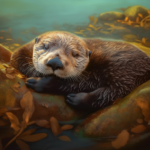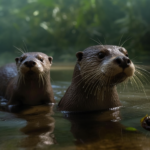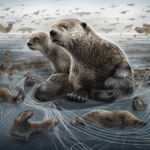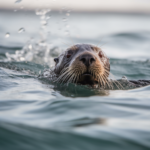River otters are fascinating creatures that inhabit rivers, lakes, and wetlands across North America. These playful and agile mammals have adapted to their aquatic lifestyle with a variety of unique features, one of which is their remarkable paws. River otter paws are specially designed to help them navigate through water and land, making them excellent swimmers and hunters. In this article, we will explore the anatomy and function of river otter paws, shedding light on the incredible adaptations that enable these adorable creatures to thrive in their watery habitats. So, let’s dive in and discover the wonders of river otter paws!
Key Takeaways
- River otter paws are uniquely adapted for life in the water.
- Their webbed toes help them swim efficiently and navigate through rivers and lakes.
- The sensitive pads on their paws provide excellent traction on slippery surfaces.
- River otters use their paws to catch and manipulate prey, such as fish and crustaceans.
- The grooming behavior of river otters involves using their paws to clean and maintain their fur.
The Fascinating Anatomy of River Otter Paws
River otters are fascinating creatures known for their playful nature and remarkable adaptations to their aquatic habitat. One of the most intriguing aspects of these animals is their paws. In this section, we will explore the anatomy of river otter paws and delve into the significance of their webbed feet and unique paw prints.
A. Do Otters Have Paws?
Yes, otters do have paws. Their paws are specially adapted for life in the water, allowing them to swim with ease and catch prey efficiently. These paws are equipped with several features that make them well-suited for their aquatic lifestyle.
-
Webbed Feet: One of the most distinguishing features of otter paws is their webbed feet. The toes of river otters are connected by a thin membrane of skin, forming a paddle-like structure. This webbing helps them propel through the water with speed and agility.
-
Claws: Otters have sharp, retractable claws on their paws, which they use for various purposes, such as catching fish, digging burrows, and grooming their fur. These claws are essential tools for their survival in the wild.
-
Sensory Pads: River otter paws also have sensory pads on the undersides, similar to those found in cats and dogs. These pads provide them with a heightened sense of touch, allowing them to navigate their environment and detect prey underwater.
B. The Significance of Webbed Feet in River Otters
The webbed feet of river otters serve a crucial role in their survival and locomotion. Let’s explore the significance of this adaptation:
-
Swimming Abilities: The webbing between their toes enables otters to paddle through the water effortlessly. This adaptation increases their surface area, providing greater propulsion and maneuverability. It allows them to swim swiftly, making them formidable hunters in their aquatic habitat.
-
Diving and Fishing: Otters are skilled divers, capable of staying submerged for several minutes. Their webbed feet aid in diving by providing better control and stability underwater. Additionally, the webbing helps them navigate through vegetation and catch fish with precision.
-
Efficient Locomotion: The webbed feet of otters allow them to move efficiently on land as well. While they are primarily aquatic animals, they often traverse short distances on land between bodies of water. The webbing reduces friction and allows them to move swiftly, making it easier for them to find suitable habitats and food sources.
C. The Unique Features of River Otter Paw Prints
River otter paw prints can be identified by their distinctive features, which provide valuable insights into their behavior and presence in an area. Here are some characteristics of otter paw prints:
-
Size: Otter paw prints are relatively small, measuring around 2 to 3 inches in length. The size of the prints can vary depending on the age and size of the otter.
-
Claw Marks: Otter paw prints often show the marks of their sharp claws. These claw marks can be seen alongside the toe impressions, indicating the presence of otters in the vicinity.
-
Webbed Shape: The webbing between the toes is sometimes visible in the paw prints, especially when the ground is soft or muddy. This feature distinguishes otter tracks from those of other animals.
-
Grouping: Otters are social animals, and their paw prints often appear in groups or clusters. This grouping can indicate the presence of a family or a group of otters in the area.
Understanding the anatomy of river otter paws and the significance of their webbed feet and unique paw prints provides valuable insights into the behavior and adaptations of these remarkable creatures. Their specialized paws enable them to thrive in their aquatic habitat, making them a true marvel of nature.
The Role of River Otter Paws in their Survival
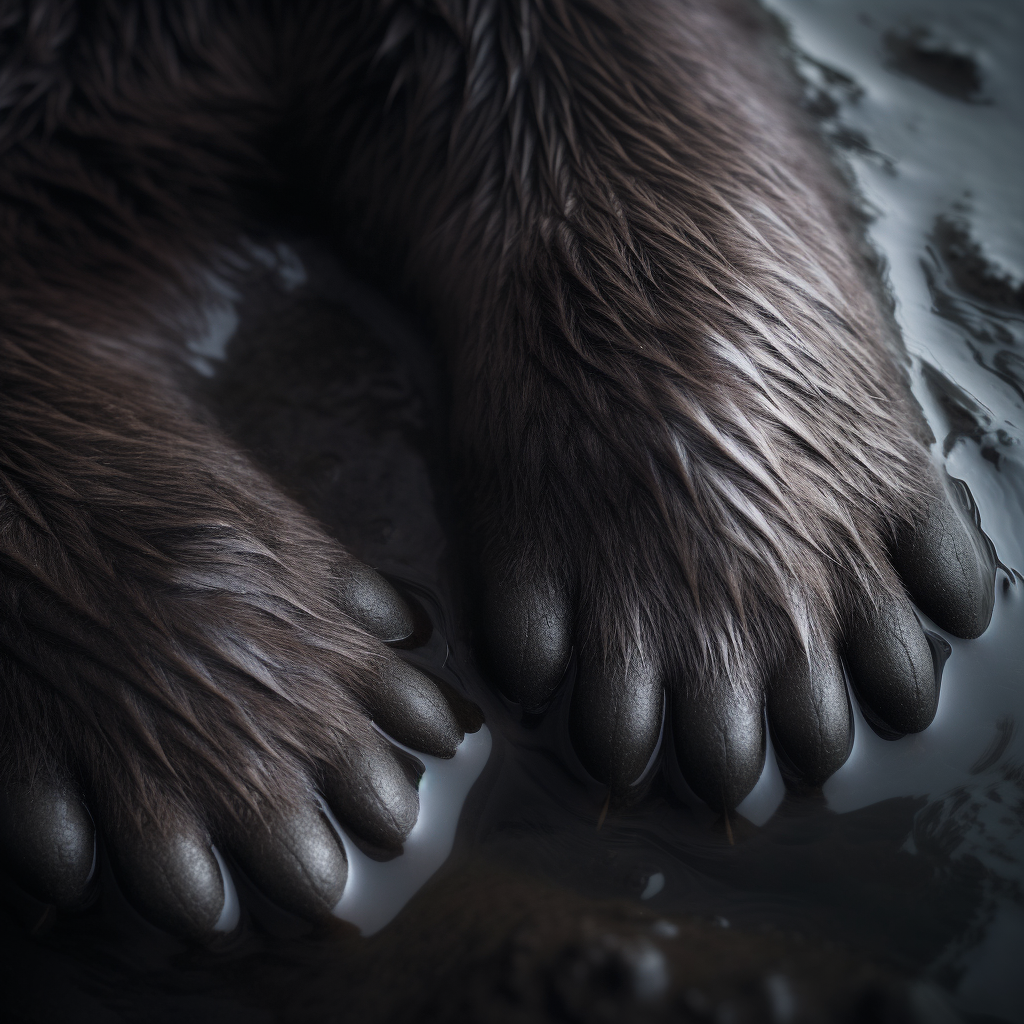
A. How River Otters Use their Paws to Protect Themselves
River otters are fascinating creatures that have adapted to their aquatic habitat in numerous ways. One of their most important adaptations is their paws, which play a crucial role in their survival. These remarkable appendages serve multiple purposes, including self-defense.
When it comes to protecting themselves, river otters rely on their strong and dexterous paws. These paws are equipped with sharp claws that help them navigate through various terrains, both on land and in water. The otters use their claws to grip onto slippery surfaces, such as rocks and logs, ensuring they maintain a firm hold while moving around.
In addition to their claws, river otters have webbed feet that aid in swimming and provide them with excellent maneuverability in the water. The webbing between their toes allows them to paddle swiftly and efficiently, making them skilled swimmers. This ability to swiftly navigate through the water is crucial for escaping potential predators or chasing after prey.
B. The Role of Paws in River Otters’ Hunting and Feeding
River otters are opportunistic hunters, and their paws play a vital role in their hunting and feeding strategies. These agile creatures primarily feed on fish, amphibians, crustaceans, and other small aquatic animals. Their paws are instrumental in capturing and securing their prey.
When hunting, river otters use their paws to search for food in crevices, under rocks, and in vegetation along the water’s edge. Their sensitive paws can detect vibrations and movements in the water, allowing them to locate potential prey. Once they spot their target, the otters use their paws to snatch the prey with precision and speed.
River otters also use their paws to manipulate and handle their food. They hold their prey firmly between their forepaws while tearing it apart with their sharp teeth. This dexterity enables them to extract every bit of meat from their catch, ensuring they get the most out of their meal.
C. The Use of Paws for River Otters’ Communication and Interaction
River otters are highly social animals that engage in various forms of communication and interaction. Their paws play a significant role in these behaviors, allowing them to express themselves and establish social bonds with other otters.
One way river otters use their paws for communication is through tactile interactions. They engage in playful behaviors with their peers, using their paws to touch and groom each other. This physical contact helps strengthen social bonds within the otter community.
River otters also use their paws to mark their territory. They have scent glands located on their paws, which they use to leave scent marks on rocks, logs, and other objects in their environment. These scent marks serve as a way for otters to communicate their presence and assert their ownership over a particular area.
In conclusion, the paws of river otters are essential for their survival. These versatile appendages enable them to protect themselves, hunt for food, and communicate with their fellow otters. By understanding the remarkable adaptations of river otter paws, we can gain a deeper appreciation for these fascinating creatures and their ability to thrive in their aquatic habitats.
The Impact of River Otters on the Ecosystem
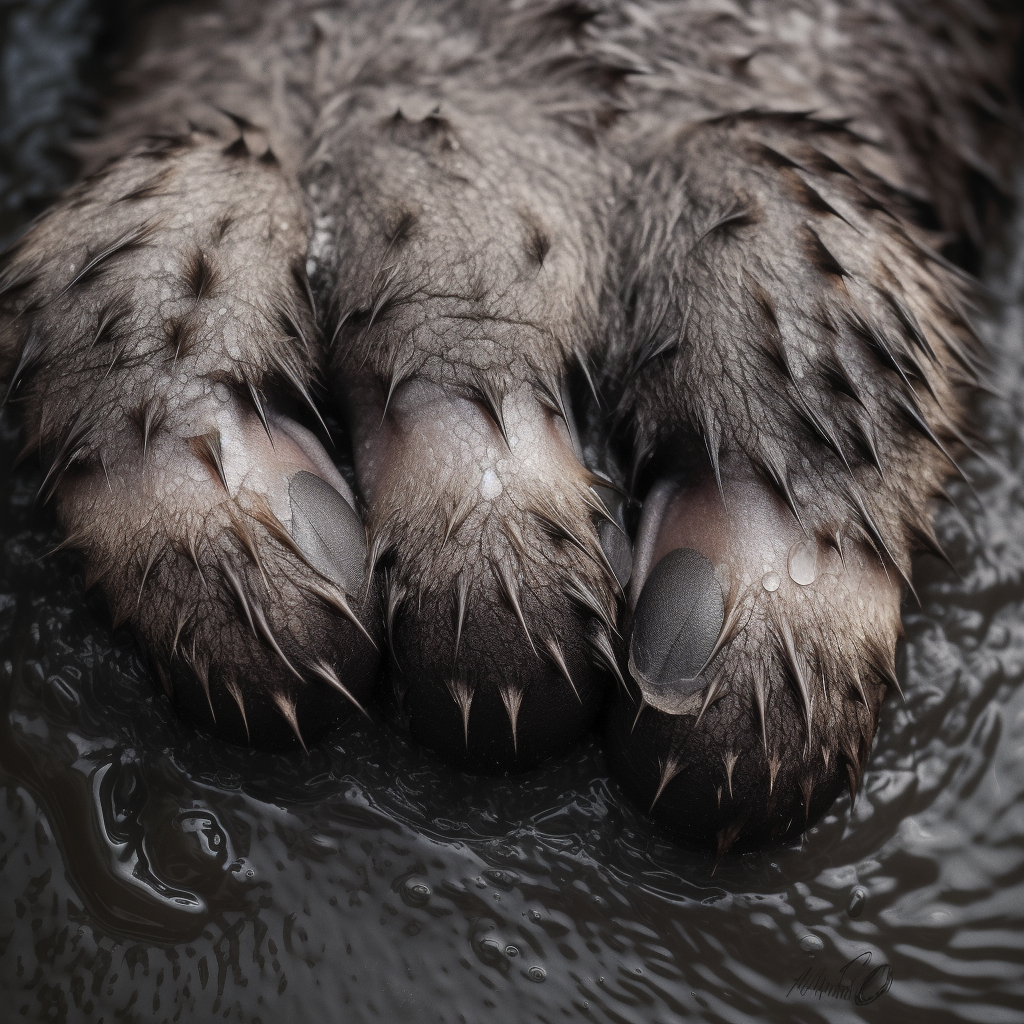
A. Why are River Otters Important to the Ecosystem?
River otters play a vital role in maintaining the balance of the ecosystem they inhabit. These charismatic aquatic mammals have a significant impact on their surrounding environment, benefiting both the flora and fauna that coexist with them.
One of the primary reasons why river otters are important to the ecosystem is their role as top predators. As skilled hunters, they help control the population of various prey species, such as fish, crustaceans, and amphibians. By regulating the numbers of these prey species, otters prevent overpopulation, which can lead to imbalances in the ecosystem.
Additionally, river otters are known to be indicators of environmental health. Their presence in a waterway indicates that the habitat is in good condition, as otters require clean water and an abundant food supply to thrive. Therefore, monitoring the otter population can provide valuable insights into the overall health of the ecosystem.
B. How Do River Otters Help the Environment?
River otters contribute to the environment in several ways. Firstly, their feeding habits help maintain the balance of aquatic ecosystems. Otters primarily feed on fish, which helps control the population of these species. By doing so, they prevent certain fish species from becoming too dominant, allowing for a diverse and healthy fish population.
Furthermore, river otters are excellent swimmers, thanks to their unique adaptations. Their webbed feet and streamlined bodies enable them to navigate through water with ease. As they swim, otters create turbulence that helps oxygenate the water, benefiting other aquatic organisms. This increased oxygenation promotes the growth of underwater plants and supports the survival of various aquatic species.
C. The Role of River Otter Paws in Maintaining Ecosystem Balance
River otter paws play a crucial role in the otters‘ ability to navigate their environment and maintain ecosystem balance. These paws are specially adapted to suit their semi-aquatic lifestyle.
One notable feature of river otter paws is their size. With their relatively large size, otter paws provide excellent propulsion in water, allowing otters to swim efficiently. The webbing between their toes further enhances their swimming abilities, enabling them to move swiftly and gracefully through the water.
Moreover, otter paws are equipped with sharp claws that aid in catching prey and climbing on land. These claws are retractable, allowing otters to keep them protected and sharp when needed. The combination of their dexterous paws and sharp claws enables otters to hunt effectively, ensuring a healthy balance in the ecosystem by controlling the population of their prey.
In conclusion, river otters have a significant impact on the ecosystem they inhabit. Their role as top predators helps regulate prey populations, while their swimming abilities and specialized paws contribute to the overall health of aquatic environments. By understanding and appreciating the importance of river otters, we can work towards preserving their habitats and ensuring the continued balance of our ecosystems.
The Life Cycle of River Otters and the Role of Paws
A. When are River Otters Born and How Paws Help Them Survive
River otters are fascinating creatures that go through a unique life cycle. Let’s take a closer look at when these adorable mammals are born and how their paws play a crucial role in their survival.
River otters typically give birth to their young during the spring or early summer. The exact timing may vary depending on the region and environmental conditions. Female otters create dens in secluded areas near water bodies, such as rivers, lakes, or marshes, to provide a safe and secure space for their offspring.
When the otter pups are born, they are completely dependent on their mother for survival. At birth, their paws are small and delicate, but they quickly grow and develop alongside the rest of their body. These paws are essential for the otter pups to navigate their surroundings and learn important survival skills.
The paws of river otters are uniquely adapted for life in the water. They are webbed, which means that the toes are connected by a thin membrane of skin. This webbing allows the otters to swim swiftly and efficiently through the water, making them excellent hunters.
The webbed paws also help the otter pups stay close to their mother. When the mother otter swims, she often carries her young on her belly, using her paws to keep them secure. The webbing between her toes acts as a natural cradle, ensuring that the otter pups don’t slip away.
B. The Role of Paws in River Otters’ Mating and Parenting
River otters are known for their playful and social nature, and their paws play a significant role in their mating and parenting behaviors. During the mating season, male otters use their paws to communicate with potential mates. They engage in playful wrestling matches, using their paws to playfully touch and interact with each other.
Once a pair has formed a bond, the male otter continues to use his paws to court the female. He may present her with small gifts, such as fish or other food items, using his paws to offer the tokens of affection. This behavior helps strengthen the bond between the pair and increases their chances of successful reproduction.
When it comes to parenting, both male and female otters are actively involved in raising their young. The parents use their paws to groom and care for the otter pups, ensuring their cleanliness and well-being. They also use their paws to teach their young how to swim, hunt, and navigate their environment.
C. When Do River Otters Come Out and How Paws Facilitate their Movements
River otters are primarily nocturnal animals, meaning they are most active during the night. However, they can also be seen during the early morning or late evening hours. These elusive creatures spend a significant amount of time in the water, where their paws play a vital role in facilitating their movements.
The paws of river otters are equipped with sharp claws, which help them grip slippery surfaces and climb onto land. This adaptation allows them to easily transition between their aquatic and terrestrial habitats. Whether they are hunting for fish, exploring their surroundings, or simply resting on the riverbank, their paws provide them with the necessary stability and agility.
Additionally, the sensitive pads on their paws help them detect vibrations in the water, allowing them to locate prey more effectively. This heightened sense of touch enables river otters to be skilled hunters, capable of catching fish, amphibians, and even small mammals.
In conclusion, the paws of river otters are not only adorable but also serve a crucial purpose in their survival and well-being. From helping otter pups navigate their surroundings to facilitating mating and parenting behaviors, these paws are truly remarkable adaptations. So, the next time you spot a river otter, take a moment to appreciate the incredible role their paws play in their fascinating life cycle.
River Otters and Human Interaction

A. The Risk and Reality of River Otters Carrying Diseases
River otters are fascinating creatures that inhabit various waterways across North America. While they may seem adorable and playful, it’s essential to understand the potential risks associated with interacting with these animals. Like any wild animal, river otters can carry diseases that can be transmitted to humans.
One of the primary concerns when it comes to disease transmission is rabies. Although cases of rabies in river otters are relatively rare, it’s crucial to exercise caution. Rabies is a viral disease that affects the central nervous system and can be fatal if left untreated. It is typically transmitted through bites or scratches from infected animals.
Another disease that river otters can carry is leptospirosis. This bacterial infection can be transmitted through contact with contaminated water, soil, or urine from infected animals. Leptospirosis can cause flu-like symptoms in humans, including fever, headache, muscle aches, and in severe cases, liver and kidney damage.
To minimize the risk of disease transmission, it’s important to avoid direct contact with river otters in the wild. Admiring them from a safe distance is the best way to appreciate their beauty without putting yourself at risk. If you come across a river otter in its natural habitat, it’s best to observe from afar and avoid any attempts to touch or handle the animal.
B. Opportunities to Observe River Otters: Aquariums and Swims Near Me
If you’re eager to witness the playful antics of river otters up close, there are alternative options that allow for a safe and controlled environment. Many aquariums and wildlife centers offer exhibits where you can observe these charismatic creatures in action.
Aquariums provide a unique opportunity to learn about river otters and their natural habitat. These exhibits often recreate a simulated river environment, complete with rocks, logs, and flowing water. Watching river otters swim, dive, and play in these settings can be an educational and entertaining experience for visitors of all ages.
In addition to aquariums, some locations offer “swims” or encounters with river otters. These experiences allow individuals to get in the water with trained otters under the supervision of experienced handlers. While these encounters can be exciting and memorable, it’s important to remember that they are highly regulated to ensure the safety and well-being of both the otters and the participants.
To find opportunities to observe river otters in your area, you can check with local aquariums, wildlife centers, or nature preserves. They often have programs or exhibits dedicated to showcasing these fascinating creatures. Keep in mind that availability may vary depending on your location, so it’s always a good idea to check ahead of time.
C. The Experience of Petting an Otter: What Does an Otter Paw Feel Like?
River otters have unique adaptations that make them well-suited for their aquatic lifestyle. One of the most notable features of their paws is their webbed structure. The webbing between their toes allows them to swim swiftly and efficiently through the water, making them excellent hunters.
If you ever have the opportunity to pet a river otter, you’ll notice that their paws are surprisingly soft and smooth. The pads on their paws provide cushioning and grip, allowing them to navigate various terrains, including slippery rocks and muddy riverbanks.
When you touch an otter’s paw, you may feel a slight dampness due to their constant exposure to water. This moisture helps keep their paws supple and aids in their swimming abilities. The sensation of an otter’s paw can be described as velvety and slightly cool to the touch.
However, it’s important to note that petting river otters is not a common practice and should only be done under controlled and supervised circumstances. Interacting with wild animals can disrupt their natural behavior and may pose risks to both the animal and the person involved. It’s always best to admire these beautiful creatures from a respectful distance and allow them to live their lives undisturbed in their natural habitat.
In conclusion, river otters are captivating creatures with unique adaptations that allow them to thrive in their aquatic habitats. While it’s important to appreciate their beauty and playfulness, it’s equally crucial to understand the potential risks associated with interacting with them. By observing river otters in controlled environments such as aquariums and wildlife centers, we can learn about and appreciate these remarkable animals while ensuring their well-being and conservation.
River Otters in Different Cultures
A. The Meaning of Otters in Sinhala Culture
In Sinhala culture, otters hold a special significance and are often associated with good fortune and prosperity. These playful creatures are believed to bring luck and happiness to those who encounter them. The otter’s agile and graceful movements in the water are seen as a symbol of adaptability and resilience, qualities highly valued in Sinhala culture.
The Sinhala people also believe that otters possess a deep connection with water, which is considered a sacred element in their culture. Otters are seen as guardians of water bodies, and their presence is believed to purify and protect these natural resources. This belief highlights the importance of environmental conservation and the need to preserve the delicate balance of ecosystems.
Moreover, otters are often depicted in Sinhala art and folklore, showcasing their cultural significance. These depictions portray otters as playful and mischievous creatures, adding a sense of joy and liveliness to the stories and artwork. The otter’s ability to navigate both land and water is also seen as a metaphor for adaptability and versatility in life.
B. The Significance of Otters in Tamil Culture
In Tamil culture, otters are revered for their intelligence and resourcefulness. They are seen as symbols of wisdom and cunning, often depicted in folklore and literature as clever and quick-witted creatures. The Tamil people admire the otter’s ability to adapt to various environments and overcome challenges, considering it a valuable trait to possess.
Tamil culture also associates otters with water, considering them guardians of rivers and lakes. Otters are believed to have a deep understanding of the water’s currents and hidden treasures, making them highly respected in Tamil society. Their presence is seen as a positive omen, signifying abundance and prosperity.
Furthermore, otters play a significant role in Tamil mythology. They are often portrayed as companions of deities and are believed to possess supernatural powers. Otters are associated with fertility and are considered protectors of families and homes. Their presence is believed to bring harmony and happiness to households.
In conclusion, otters hold a special place in both Sinhala and Tamil cultures. They are revered for their adaptability, intelligence, and connection to water. Whether as symbols of good fortune or embodiments of wisdom, otters continue to captivate the imagination and inspire cultural expressions in these diverse communities.
Otter Species Comparison: River Otter vs Sea Otter
A. Differences in Paws and Adaptations
When comparing river otters and sea otters, one noticeable difference lies in their paws and adaptations. While both species have unique characteristics, their paws play a crucial role in their survival and daily activities.
River Otter Paws
River otters, also known as North American river otters, have paws that are specifically adapted for life in and around water. Their paws are webbed, which means that the toes are connected by a membrane of skin, allowing them to swim more efficiently. This webbing acts like flippers, enabling river otters to navigate through water with ease.
The size of river otter paws varies depending on the individual’s age and size. Adult river otters typically have larger paws compared to younger otters. The larger size allows them to have better propulsion and maneuverability in the water.
In addition to their webbed paws, river otters have sharp claws that aid in catching prey and climbing onto riverbanks. These claws are retractable, meaning they can be extended or retracted as needed. When hunting, river otters use their claws to grab fish and other aquatic creatures, demonstrating their impressive hunting techniques.
Sea Otter Paws
Sea otters, on the other hand, have slightly different adaptations when it comes to their paws. Unlike river otters, sea otters have larger and more robust paws. Their front paws are larger than their hind paws, which helps them with activities such as grooming and manipulating objects.
Sea otters have a unique adaptation on their hind paws known as a “pouch.” This pouch-like structure is located on the underside of their hind feet and acts as a storage area for food. When sea otters dive underwater to hunt for food, they can use their paws to store captured prey in this pouch, allowing them to bring it to the surface for consumption.
Similar to river otters, sea otters also have webbed paws. However, their webbing is more extensive and extends all the way to the tips of their claws. This adaptation enables sea otters to be exceptional swimmers, as their webbed paws provide maximum surface area for efficient propulsion through the water.
B. The Cost of Otter App for Species Identification and Learning
If you’re interested in learning more about otter species, including their paws and other unique characteristics, there’s an app available that can help you with species identification and learning. The Otter App is a comprehensive tool designed to provide information on different otter species, their behavior, habitat, diet, and more.
The Otter App offers a user-friendly interface, making it easy for both beginners and enthusiasts to navigate. With just a few taps, you can access detailed information about river otters, sea otters, and other otter species from around the world.
In addition to species identification, the Otter App also includes educational resources such as videos, images, and interactive quizzes. These features allow users to deepen their understanding of otters and their unique adaptations, including their paws.
The cost of the Otter App varies depending on the subscription plan you choose. There are options for monthly, quarterly, or annual subscriptions, allowing you to select the plan that best suits your needs and budget. By investing in the Otter App, you’ll have a wealth of knowledge at your fingertips and gain a greater appreciation for these fascinating creatures.
In conclusion, river otters and sea otters have distinct differences in their paws and adaptations. While river otters have webbed paws for efficient swimming and sharp claws for hunting, sea otters have larger paws with a unique pouch-like structure on their hind feet. Both species showcase remarkable adaptations that contribute to their survival in their respective habitats. With the help of the Otter App, you can further explore the world of otters and deepen your understanding of these incredible creatures.
Conclusion
In conclusion, the paws of river otters are remarkable adaptations that enable these playful creatures to thrive in their aquatic habitats. With their webbed toes, strong claws, and sensitive pads, river otters are well-equipped for a life spent both in and out of the water. Their paws allow them to swim swiftly and gracefully, while also providing excellent traction on land. The webbing between their toes acts like flippers, aiding in propulsion through the water. The claws on their paws are sharp and versatile, helping them catch prey, climb trees, and dig burrows. Additionally, the sensitive pads on their paws allow them to navigate their surroundings with precision, detecting vibrations and changes in temperature. Overall, the paws of river otters are a testament to the incredible adaptability and agility of these fascinating creatures.
Frequently Asked Questions
How much does the Otter app cost?
The cost of the Otter app can vary depending on the subscription plan you choose. It’s best to check their official website or app store listing for the most accurate and up-to-date pricing information.
How do river otters protect themselves?
River otters have several defense mechanisms. They can use their sharp teeth and strong jaws to bite predators. Their agility in water also allows them to escape from threats. Moreover, their dark fur helps them blend into their surroundings, providing a form of camouflage.
Do river otters carry diseases?
Yes, river otters can carry diseases, including parasites and bacterial infections. However, these diseases are generally not a threat to humans unless they are directly exposed to the otter or its feces.
Can you describe a river otter paw print?
A river otter paw print is distinctive. It usually shows five toes and the presence of webbing, which aids in their swimming. The print may also show the impression of their claws, which are sharp and used for hunting.
Why are river otters important?
River otters play a crucial role in maintaining the health of aquatic ecosystems. They help control the population of certain species, like crayfish and fish, which can influence the overall biodiversity. They are also an indicator species, meaning their presence, absence, or abundance provides information about the overall health of the ecosystem.
When do river otters come out?
River otters are mostly nocturnal, meaning they are most active during the night. However, they can also be seen during the early morning or late afternoon. Their activity can vary depending on factors like food availability and human presence.
Where can I find an otter aquarium near me?
The location of otter aquariums can vary widely depending on where you live. It’s best to search online or contact local wildlife centers or zoos to find an otter aquarium near you.
Why are river otters important to the ecosystem?
River otters are important to the ecosystem as they help control the population of certain aquatic species, maintaining a balance. Their presence or absence can also indicate the health of the ecosystem, making them an important species for conservation efforts.
How do river otters protect themselves from predators?
River otters use their agility in water, sharp teeth, and strong jaws to protect themselves from predators. They can also use their fur as camouflage to blend into their surroundings.
When are river otters born?
River otters typically give birth in late winter or early spring. The exact timing can vary depending on the geographical location and specific species of the otter.

